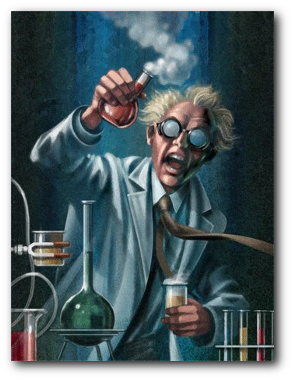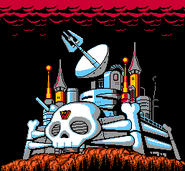Explanation of the Pyweek 14 themes
This is for non-native English speakers, or people who need to hear the cultural context of these phrases, or are just stuck for ideas. Also be sure to check out Ernie's post on the themes, and add your own ideas!Mad science is fringe science with ambitious and bizarre goals and methods, pursued with no regard for, or even because of, its destructive potential. The mad scientist stereotypically dons a lab coat and Einstein haircut, and works for the villain, if not being the villain himself. They're brilliant but monomaniacal and sociopathic, if not downright evil.

They're always inventors of some sort, with such outlandish inventions as death rays, killer robots, superweapons, or biological monsters. Classic mad scientists include Dr Frankenstein, Dr Jekyll, Dr Moreau, and Rotwang from Metropolis. Modern characters based on classic mad scientists include Dr Honeydew from The Muppet Show, Doc Brown from Back to the Future, Beakman from Beakman's World, Dexter from Dexter's Laboratory, and Dr Farnsworth from Futurama. Mad can refer to many things, but here it means insane, as in mad as a hatter or mad as a March hare. More at TV Tropes.

A secret lair is a superhero or supervillain headquarters in a secret location. Common forms include an abandoned warehouse at the edge of town, a space station, a remote island, an underground bunker, and a base at the bottom of the ocean.

Secret lairs serve as a base of operations to formulate plans, store weapons, and hold prisoners. They're often the location of the final showdown, and have a tendency to collapse dramatically, leaving behind no evidence. Many things can be kept secret, such as secret ingredient, secret password, trade secret, and secret weapon. A lair is protected place where a wild animal or monster lives, such as a bear, lion, dragon.

Everything goes to hell when a disaster strikes. It refers to hell, a place of suffering in the afterlife of many religions. Hell is associated with punishment, pain, torment, evil demons, fire, underground caverns, chaos, oblivion, and imprisonment. Modern depictions of Christian hell are largely influenced by Dante's Inferno. More at TV Tropes.

You can tell someone to go to hell if you're mad at them. You can acknowledge your (usually minor) sins by saying I'm going to hell. Someone on the fast track to hell is going to hell in a handbasket. The phrase everything goes to hell usually doesn't literally mean hell, it means the situation is deteriorating into chaos. You might use this phrase in the zombie apocalypse, riots, or war zones. Another phrase for it is all hell breaks loose.

Delinquency means breaking some rule somehow, usually minor or moderate misbehavior. Calling someone a delinquent is less severe than calling them a criminal, but the exact legal distinction varies. Juvenile delinquency is a special class of criminal justice dealing with illegal behavior by minors. Typical offenses of juvenile delinquents are vandalism, drug use, and shoplifting. Failure to pay a debt is debt delinquency. A delinquent parent is one who fails to pay child support.

Daffodils or tulips are flowers. Like many flowers, they're cultivated as gifts and decoration. They're fairly normal, generic flowers, without strong associations with romance or any specific ceremony or event, but flowers are generally associated with beauty and peace.

Daffodils are usually yellow or white. They're also called narcissus, after a mythological young man who fell in love with his reflection and turned into a flower. Tulips come in many colors, including pink, red, yellow, purple, and white. They're still popular in Holland, where tulip mania, an economic bubble where a single tulip bulb could sell for the cost of a house, struck in the 1630s.

(log in to comment)
Comments
Good work. I might give some examples of secret lairs in movies or books, but otherwise these explain the themes perfectly.
TV tropes has an article on supervillain lairs. Not all of them are secret, however, and it doesn't list lairs of superheroes or beasts, but it's got a lot of good examples. More heroes' examples are given under To the Batpole!.
Off the top of my head: classic examples include Batman's Batcave, Superman's Fortress of Solitude, and just about every James Bond film. Examples based on the classic trope appear in The Incredibles, Austin Powers, Darkwing Duck, Invader Zim, Dexter's Laboratory, and The Emperor's New Groove.
Off the top of my head: classic examples include Batman's Batcave, Superman's Fortress of Solitude, and just about every James Bond film. Examples based on the classic trope appear in The Incredibles, Austin Powers, Darkwing Duck, Invader Zim, Dexter's Laboratory, and The Emperor's New Groove.
Oh and of course Beowulf. Can't forget Grendel's den! The dragon in The Hobbit probably had a lair too, I don't remember....
Yeah, Smaug had a lair. It wasn't secret though.
 Ernie on
2012/05/01 10:59:
Ernie on
2012/05/01 10:59:
Nice!Thank you very much. The illustrations at least double the awesomeness. : )